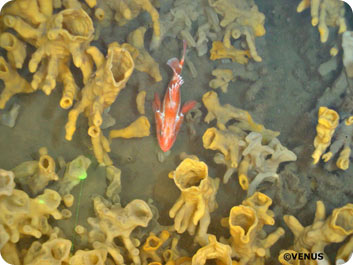A house made of glass may not seem like the ideal shelter, that is, unless you’re a certain kind of tiny marine creature. Fragile and beautiful cities composed of these glass homes are created by only a few unique species of sponges and can cover miles of ocean floor, forming what are known as glass sponge reefs.
 A rockfish glides over the intricate formations of a glass sponge reef in Georgia Strait near British Columbia, Canada. Credit: VENUS/University of Victoria
A rockfish glides over the intricate formations of a glass sponge reef in Georgia Strait near British Columbia, Canada. Credit: VENUS/University of VictoriaHow do sponges create a reef? Glass sponges get their name from the silica that makes up their skeletons. They can grow to about 1-1/2 feet tall and they resemble wrinkled trumpets. They can live up to 200 years, and when they die, they leave their rigid skeletons behind. New sponges grow on the piles of old skeletons, and over time, a massive and complex reef takes shape.
Like coral reefs, glass sponge reefs bustle with life. They provide shelter for crabs, shrimp, sardines, and rockfish. The reefs are so crowded that scientists have described them as hotels for small creatures. Scientists believe that the glass sponges themselves may be nourished by bacteria that feed on methane and other gases that percolate up through the ocean floor near some of these sponge communities.
Until recently, scientists thought the three rare species of glass sponges capable of building reefs were extinct. But since the early 1990s, thriving glass sponge colonies have been found off the coast of Washington and British Columbia. Scientists now believe there may be many cities of glass in the ocean, just waiting to be discovered.


